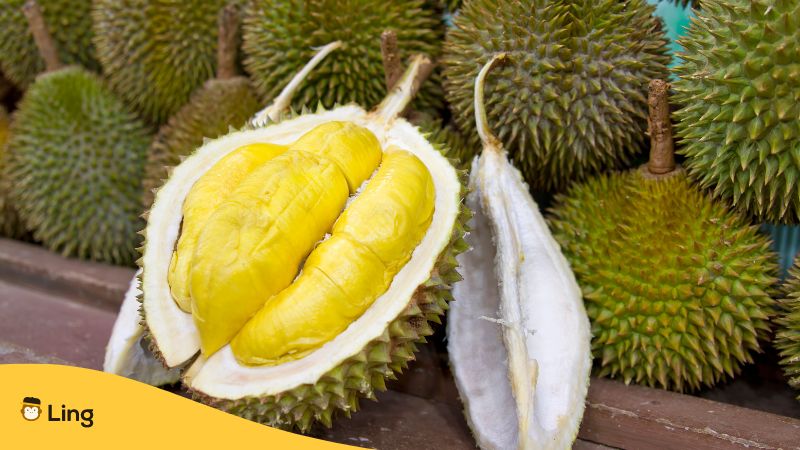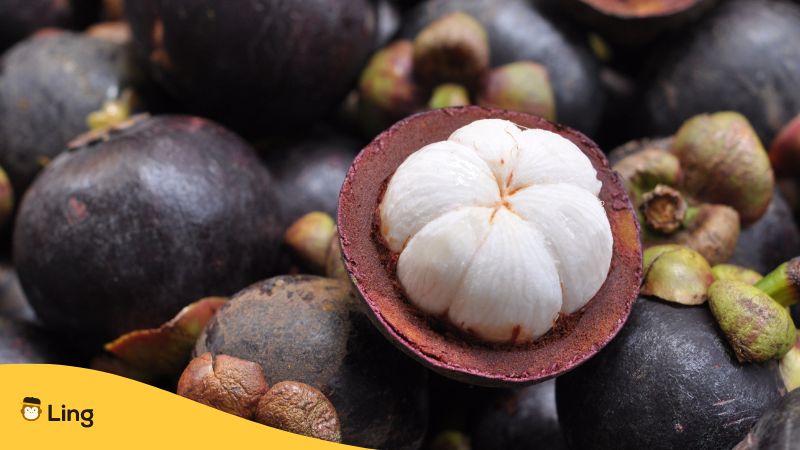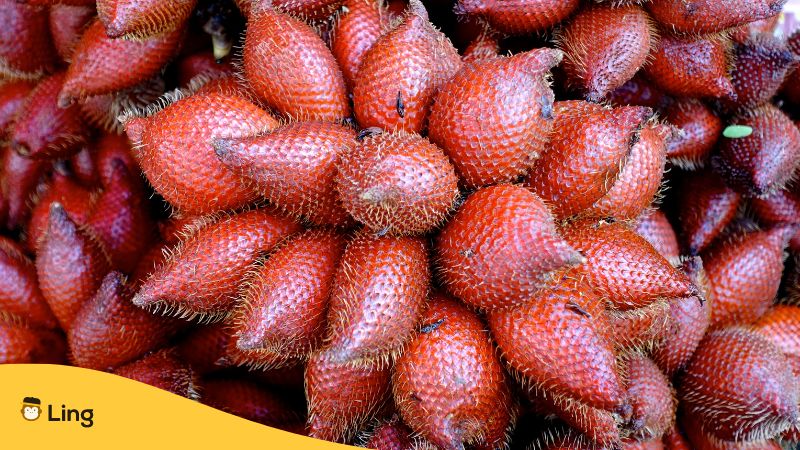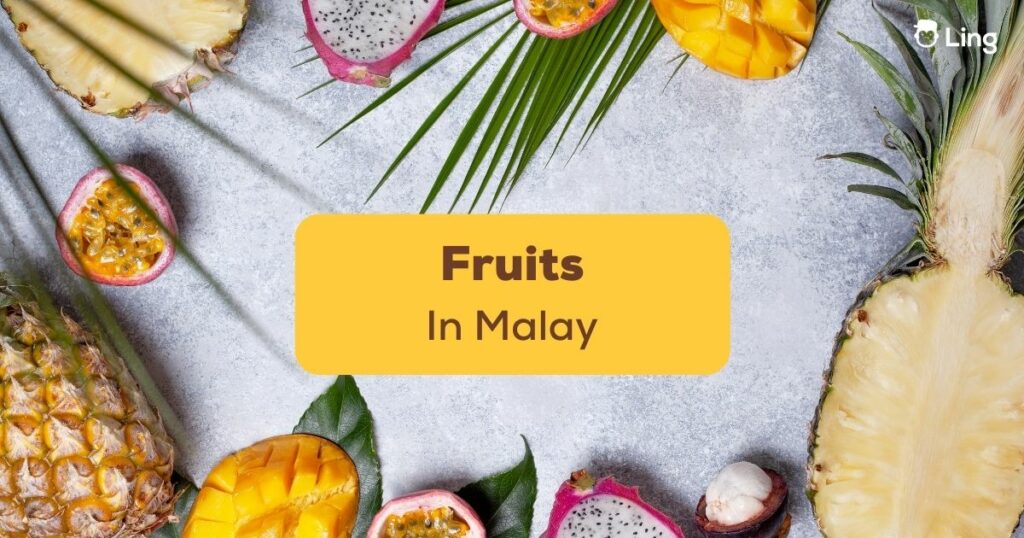When it comes to food in Malaysia, you can’t forget the fruit. Delicious, juicy, and varied fruit, the kind that you can only find in Malaysia and parts of Southeast Asia! If you’re a fan of these tropical fruits, then you’re in luck: today, we’re taking a look at the names of fruits in Malay!
Of course, we’re not just going to talk about their fruit names – that’d be boring! We’ll discuss some of the best fruits Malaysians love, how they taste, how they’re eaten, and what their names are in their native language.
Hungry? You haven’t seen anything yet!
Fruits In Malay | What Malaysians Get For A Fruity Fix
Durian

Regarding fruits in Malay, this name means the same in any language: durian. Called the “King of Fruits,” durian is native to Southeast Asia, including Malaysia, Indonesia, Thailand, and the Philippines.
The fruit’s outside has spiky, tough green or brown skin, depending on how ripe it is. Its appearance is reminiscent of jackfruit! Durian is humongous, with some variants reaching up to 7 pounds big! But don’t let the thorns, size, and smell scare you away — the flesh inside the fruit is absolutely delicious!
Each durian contains about 6 to 10 segments inside, each with big seeds. Malaysians love to roast the seeds and eat them like nuts!
In Malaysia, the most common variety of durian is called Musang King. It is super sweet yet can still taste savory and creamy! Some people may describe this type of durian as a mix of caramel, whipped cream, and diced garlic.
While Malay people may prefer to eat durian raw, those who find the flavor too overwhelming may find durian confectionaries more palatable. As a result, people have turned durian into candy, cake, smoothies, and more!
And speaking of overwhelming, durian is banned from most public transport because of its potent smell. People are just jealous.
Rambutan
When discussing fruits in Malay, we can’t leave rambutan behind. Even the name has Malay origins: rambut means hair in Malay, which shows in the appearance of the fruit itself!
While it is part of the same fruit family as the lychee, longan, mamoncillo, and pulasan, the rambutan’s striking appearance remains unique worldwide. True to its name, the fruit is covered in spiky rambut all over its outer skin.
This fruit was first cultivated in Malaysia and Indonesia, but over time has been grown in other Southeast Asian countries such as Vietnam, Thailand, Philippines, and even in parts of Africa and Central America.
You’d be hard-pressed to miss this unique fruit when you visit the country! Its oval shape and tough, leathery skin may have yellow, orange, or reddish tones. But don’t let that fool you – inside hides a juicy, sweet, and tangy treat just waiting to be devoured!
It tastes sweet and sour — the closest fruit to its taste would be grapes. The smell, while powerful, is nowhere near as unpleasant as durian, and rambutan can be smelled from pretty far out! Eat it fresh by itself, or use it as a topping for desserts or cocktails.
Mangosteen

If there’s a king, there’s got to be a queen: and the humble mangosteen is called the queen of Malaysian fruits. This super popular dessert fruit in Malaysia may be seen served after a hefty, greasy meal.
Grown initially from islands in the Indian Ocean, Malaysia’s mangosteen variants have a more purplish hue, giving it the nickname “purple mangosteen.” Mangosteen is grown all over Southeast Asia, India, and South and Central America.
This fruit is considered a queen because they usually grow in the same season as durian. Thanks to its velvet red or deep purple color, thick skin, and protrusions around the stem, you’ll know it’s mangosteen.
Opening it up requires either your hands or a spoon. The flesh is divided into 4 to 8 white segments reminiscent of peeled garlic. But unlike peeled garlic, it tastes tangy and sweet – if a bit seedy.
Malaysians are crazy about mangosteen, so much so that they prepare it in canned and frozen versions too! It has also been used in salads, jams, tea, and candies. There are even supplements featuring mangosteen as an ingredient, owing to its vitamins and minerals that make it a healthy option for controlling blood pressure and lowering your cholesterol!
Dokong
A favorite of gossiping aunties, dokong is one of the most popular fruits in Malaysia. It is known as lanzones or longan in other countries. Still, since we’re talking about fruits in Malay, we will call it by its Bahasa Melayu name!
This natural fruit is a crucial commercial product in Southeast Asia and India. It is small and comes in various round or elliptical shapes. Its skin features a yellow, hairy texture.
But as with most fruits we’ve talked about today, the real joy is when you peel it off. The juice flesh inside comes divided into segments. While it is sweet and tart, be careful of the bitter seeds!
Malaysians typically eat this fresh, usually when hanging out with each other. However, you may find an old makcik that might use dokong as a cure for diarrhea!
Salak

Salak, or snake fruit, is the most intimidating Malay fruit on this list – but it also looks like one of the tastiest! Originating from Indonesia’s Java and Sumatra regions, this fruit made its way to become famous in Malaysia (even showing up as a stamp in 1999!)
Most people are put off by the reddish-brown scaly skin, but they don’t stick around long enough to find the pinkish, soft flesh inside! After peeling off most of the skin, you might find two or three lobes of fruit, all containing seeds inside. Peel off the meat from the seed, and you’ll enjoy a taste reminiscent of pineapple and banana flavors!
One exciting thing about snake fruit is how its texture ranges from dry to moist, crunchy, or crumbly. But one thing’s for sure: it will taste good every single time.
Betik
We can’t forget this orange number if we’re going to talk about the best fruits in Malaysia! The papaya, known as betik in Malay, is a vitamin-filled treat with a rich taste and a unique look that sets it apart from other fruits!
While papayas are sold all around the world, they originally came from southern Mexico and Central America and eventually made their way to Southeast Asia, where people went bananas as they became a popular and easily accessible fruit!
In Malaysia, locals may use unripe papaya as an ingredient. It can usually be found in salads, stews, and some curries. When unripe, papaya is a mild-tasting and crunchy treat.
Fully ripe, however, it becomes an entirely different fruit! Its orange flesh has a neutral sweetness, accentuated by its soft, smooth, and creamy texture – almost like a banana but more delicate.
Its unique buttery texture makes it great for making smoothies, ice cream, and other sweet treats. Some Southeast Asian countries even sell papaya soap!
List of Names of Malay Fruits
Here’s a list of the names of the fruits we’ve discussed today, plus a few extra words to help you when you visit Malaysia to eat all the fruits you want!
| English | Malay |
| Durian | Durian |
| Rambutan | Rambutan |
| Mangosteen | Manggis |
| Longkang | Dokong |
| Snake fruit | Salak |
| Papaya | Betik |
| Pineapple | Nenas |
| Bananas | Pisang |
| Apple | Epal |
| Tomato | Tomato |
| Pomelo | Limau besar |
| Watermelon | Tembikai |
| Sweet | Manis |
| Tangy | Kusut |
| Delicious | Lazat |
| Yummy | Sedap |
Learn More Malay Fruits With Ling App

There’s more to the Malay language than just learning the fruit names! Malay is a rich language with tons to know about it, and we’ve got just the thing to get you started…
Welcome to the Ling app, your best platform to learn all about the Malay language! Its lessons were created in partnership with teachers and native speakers, so you can have a valuable learning experience no matter your skill level.
Learn Malay or any of the 60+ languages by downloading the Ling app for Android or iPhone today!


































































